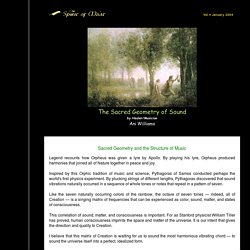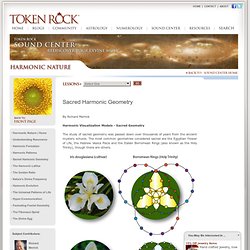

The Sacred Geometry of Sound. Sacred Geometry and the Structure of Music Legend recounts how Orpheus was given a lyre by Apollo.

By playing his lyre, Orpheus produced harmonies that joined all of Nature together in peace and joy. Inspired by this Orphic tradition of music and science, Pythagoras of Samos conducted perhaps the world's first physics experiment. By plucking strings of different lengths, Pythagoras discovered that sound vibrations naturally occurred in a sequence of whole tones or notes that repeat in a pattern of seven. Sacred Harmonic Geometry. By Richard MerrickHarmonic Visualization Models - Sacred Geometry The study of sacred geometry was passed down over thousands of years from the ancient mystery schools.

The most common geometries considered sacred are the Egyptian Flower of Life, the Hebrew Vesica Piscis and the Italian Borromean Rings (also known as the Holy Trinity), though there are others. The reason such geometry was considered sacred is due to their similarity to organic geometries found in life. Music Has Its Own Geometry, Researchers Find. The connection between music and mathematics has fascinated scholars for centuries.

More than 2000 years ago Pythagoras reportedly discovered that pleasing musical intervals could be described using simple ratios. And the so-called musica universalis or "music of the spheres" emerged in the Middle Ages as the philosophical idea that the proportions in the movements of the celestial bodies -- the sun, moon and planets -- could be viewed as a form of music, inaudible but perfectly harmonious. Now, three music professors -- Clifton Callender at Florida State University, Ian Quinn at Yale University and Dmitri Tymoczko at Princeton University -- have devised a new way of analyzing and categorizing music that takes advantage of the deep, complex mathematics they see enmeshed in its very fabric.